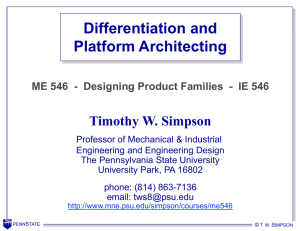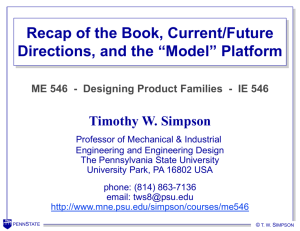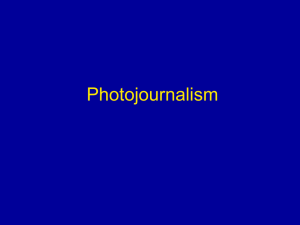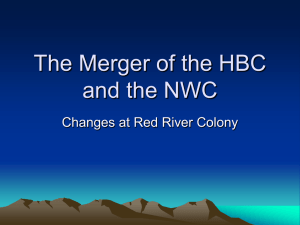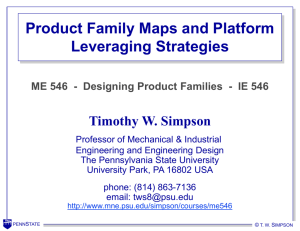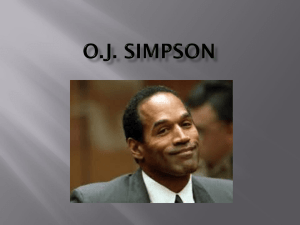PPT
advertisement
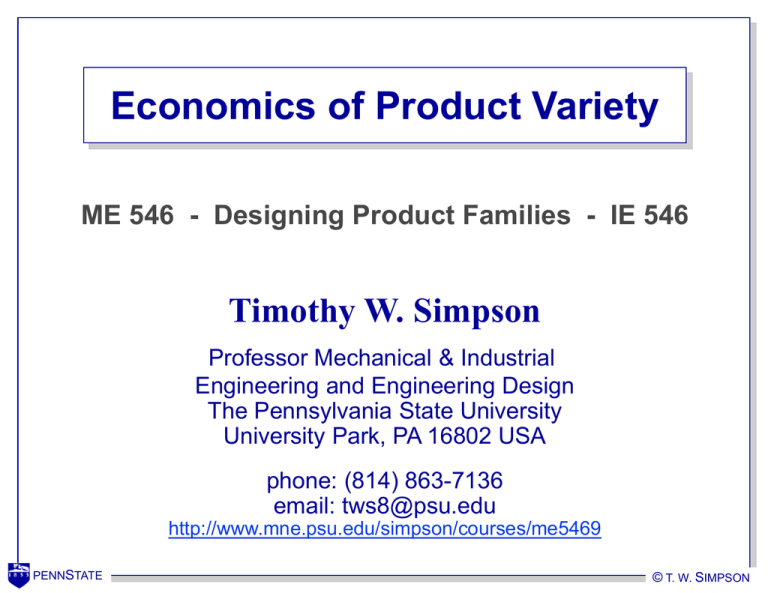
Economics of Product Variety ME 546 - Designing Product Families - IE 546 Timothy W. Simpson Professor Mechanical & Industrial Engineering and Engineering Design The Pennsylvania State University University Park, PA 16802 USA phone: (814) 863-7136 email: tws8@psu.edu http://www.mne.psu.edu/simpson/courses/me5469 PENNSTATE © T. W. SIMPSON Affordable Customization and Variety • Must consider cost, control, time constraints Custom Engineering Customization Contribution • Reactive vs. proactive modes of customization 100 % Change or Modify “Standard” Designs and Processes Easy to Customize • Best to strive for platforms – Standard Parts product and and Modules process – that 0% allow you to be Reactive Proactive proactive Adapted from: Anderson, D.M., 1997, Agile Product Development for Mass Customization, Irwin, Chicago, IL. PENNSTATE © T. W. SIMPSON Types and Cost of Variety • External Variety Useful variety is appreciated by the customer: useful options, stylistic differences Useless variety is transparent, unimportant, and confusing to the customer Example: Nissan steering wheels • Internal Variety Excessive and unnecessary variety of parts, features, tools, fixtures, raw materials, processes • Cost of Variety Is the sum of all the costs of attempting to offer customers variety with inflexible products that are produced in inflexible factories and sold through inflexible channels Includes cost of customizing, excess parts, procedures, and processes, excess operations costs PENNSTATE © T. W. SIMPSON Variety Cost With increased market variety, mass production causes a high cost of variety, whereas mass customization keeps the variety cost low (that is provided it is proactively undertaken) PENNSTATE MP High Variety Cost MC Low Low High Market Variety Adapted from: Anderson, D.M., 1997, Agile Product Development for Mass Customization, Irwin, Chicago, IL. © T. W. SIMPSON Key Drivers of Variety Cost • Lot Size (Batch Size) Determined by setup: large setups encourage large lot size • WIP Inventory Usually at least one batch of parts before and after every workstation The larger the batch size, the higher the WIP inventory • Floor Space Increase with increasing batch size Due to internal transportation costs, floor space, aisles, etc. • Recurring Quality Costs “Pipeline Effect”: Recurring errors that affect the number of parts needing to be scrapped or reworked from recurring defects downstream PENNSTATE © T. W. SIMPSON Key Drivers of Variety Cost Effect of Lot Size on Various Costs (Galsworth, 1994) • These costs usually increase with increasing lot size Cost • WIP Inventory has largest impact 1 PENNSTATE Lot Size © T. W. SIMPSON Key Drivers of Variety Cost Machinery & Setup Costs based on Lot Size (Galsworth, 1994) • Machinery Utilization The cost of less than 100% utilization Cost • Setup Includes physical setup, design changes, part distribution, additional testing Machinery 100% Utilization 1 • Cost decreases with increasing lot size Setup Labor • Counters previous trend 1 PENNSTATE Lot Size © T. W. SIMPSON Variety Cost Components • Inventory Carrying costs: Sum of all costs for interest, taxes, depreciation, handling, floor space, etc. Raw materials: Grows in an attempt to overcome deficiencies WIP: Many operators hold inventory “just in case” Finished goods: Located at distributors, dealers, in house • Inventory Related Administration: Admin labor to order, receive, document, store, retrieve, distribute, reorder Floor Space: “Inventory expands to fill the space available” Obsolescence/Deterioration: Sit in warehouse too long, run risk of uselessness Transportation: Large bins, forklifts, wide aisles all due to large batch size PENNSTATE © T. W. SIMPSON Variety Cost Components • Setup Labor cost: change a production operation from one part to another, test new setup Measured from last part of previous batch to first good part of new batch Kitting: gathering all parts necessary to build a batch of products • Model Changeovers Includes opportunity cost of lost output plus the cost of new equipment, tooling, and labor • Materials MRP: Materials Requirements Planning BOM: Bills of Materials, one needed for each different product Internal parts distribution Purchasing: Cost of buying many low-volume parts PENNSTATE © T. W. SIMPSON Variety Cost Components • Operations Tooling/dies/fixtures Ramp delays: Slow introduction of product • Customization/Configuration Plant labor Engineering: Often done without prior product line planning • Marketing Product line management Missed opportunities: Wrong amount product at wrong time Forecasting errors: Cause product shortages • Quality • Service Cost of excess service due to excessive parts and procedures • Flexibility Achieved through flexible info and manufacturing systems Actually an investment, not a cost PENNSTATE © T. W. SIMPSON Assessing Direct Costs of Product Variety • Assessing the direct costs of variety are easy (DFM) DFM is good for assessing direct costs associated with the design and production of a single product The resulting product is not “optimum” but has reduced manufacturing costs as a result of applying DFM • What are examples of direct costs involved with product variety? Capital equipment Assembly costs Manufacturing costs Supplier/vendor costs Material costs Training Component costs Drawing fabrication Labor costs PENNSTATE © T. W. SIMPSON Assessing Indirect Costs of Product Variety • Indirect costs are not always understood or easy to capture, e.g., logistics of managing variety quality capacity change due to set-ups raw material inventory part documentation work-in-process inventory finished goods inventory post-sales service • Furthermore, assessing indirect costs is not easy • Design for Variety (DFV) defines three indices to assess indirect costs of offering product variety: Commonality Differentiation Point Set-Up Cost PENNSTATE Source: (Martin & Ishii, 1998) © T. W. SIMPSON Evolution of Design for Variety (DfV) Methodology • Ishii, K., Juengel, C. and Eubanks, C. F., 1995, September 17-20, "Design for Product Variety: Key to Product Line Structuring," Design Theory and Methodology - DTM'95, Boston, MA, ASME, Vol. 83-2, pp. 499-506. • Martin, M. and Ishii, K., 1996, August 18-22, "Design for Variety: A Methodology for Understanding the Costs of Product Proliferation," Design Theory and Methodology - DTM'96 (Wood, K., ed.), Irvine, CA, ASME, Paper No. 96-DETC/DTM-1610. • Martin, M. V. and Ishii, K., 1997, September 14-17, "Design for Variety: Development of Complexity Indices and Design Charts," Advances in Design Automation (Dutta, D., ed.), Sacramento, CA, ASME, Paper No. DETC97/DFM-4359. • Fujita, K. and Ishii, K., 1997, September 14-17, "Task Structuring Toward Computational Approaches to Product Variety Design," Advances in Design Automation (Dutta, D., ed.), Sacramento, CA, ASME, Paper No. DETC97/DAC-3766. • Fujita, K., Akagi, S., Yoneda, T. and Ishikawa, M., 1998, September 13-16, "Simultaneous Optimization of Product Family Sharing System Structure and Configuration," ASME Design Engineering Technical Conferences - Design for Manufacturing, Atlanta, GA, ASME, Paper No. DETC98/DFM-5722. • Fujita, K., Sakaguchi, H. and Akagi, S., 1999, September 12-15, "Product Variety Deployment and Its Optimization Under Modular Architecture and Module Commonalization," ASME Design Engineering Technical Conferences - Design for Manufacturing, Las Vegas, NV, ASME, Paper No. DETC99/DFM-8923. • Martin, M. and Ishii, K., 2000, September 10-13, “Design for Variety: A Methodology for Developing Product Platform Architectures,” ASME Design Engineering Technical Conferences Design for Manufacturing, Baltimore, MD, ASME, Paper No. DETC2001/DFM-14021. PENNSTATE © T. W. SIMPSON Commonality Index (CI) • Commonality Index (CI) measures how well the design utilizes standardized parts CI 1 v u max p j n p j max p j j1 • u = # of unique parts • p = # of parts in model j • vn = total amount of variety offered PENNSTATE © T. W. SIMPSON Differentiation Index (DI) • Differentiation Index (DI) measures where the point of differentiation occurs within the process flow n DI div iai i1 n nd1v n ai i1 • • • • • • Reflects to what extent the product structure has moved away from the worst case scenario Indicates worst possible case wherein all variety is determined in the first process and all the costs are incorporated at that point vi = # of different products exiting process i n = # of processes vn = final # of varieties offered di = average throughput time for process i to sale d1 = average throughput time from beginning of production to sale ai = value added at process i PENNSTATE © T. W. SIMPSON Manufacturing Postponement • The concept of “postponement” is a form of DFM that is applicable when producing families of products • Postponement is defined as “redesigning the product or production process so that the point of differentiation is delayed as much as possible” a.k.a. delayed product differentiation (DPD), product differentiation postponement (PDP), design for localization • General postponement strategies: Component and Process Standardization Modular Product Design Process Restructuring Design for Logistics PENNSTATE © T. W. SIMPSON General Postponement Strategies • Component and Process Standardization allow facilities to perform identical operations reduces complexity of operations increases flexibility of WIP inventory usage • Modular Product Design allows for easier assembly integration can be performed at later points • Process Restructuring Postponement of operations (postpone operations downstream) Reversal of operations (re-order adjacent operations) • Design for Logistics designing products for cheaper transportation, with smaller packaging to reduce freight costs PENNSTATE © T. W. SIMPSON Standardization (HP) Mono Printer PCA FA&T Customization Color Printer PCA FA&T Customization No Delayed Product Differentiation Mono Printer PCA FA&T Color Printer Customization With Delayed Product Differentiation PENNSTATE © T. W. SIMPSON Reversal of Operations (Benetton) Process Restructuring: Reversal of Operations Red Sweater dye knit distribution Blue Sweater dye knit distribution No Delayed Product Differentiation Red Sweater dye distribution Blue Sweater knit dye distribution With Delayed Product Differentiation PENNSTATE © T. W. SIMPSON Process Restructuring: Postponement of Operation Postponement of Operations (Sherwin-Williams) Color A Pigment Mixing / Shipping Distribution Color B Paint Base Pigment Mixing / Shipping Distribution No Delayed Product Differentiation Color A Pigment Mixing/ Distribution Paint Base Color B Shipping Pigment Mixing/ Distribution With Delayed Product Differentiation PENNSTATE © T. W. SIMPSON Process Sequence Graphs before DPD • Instrument panels at TENKO before applying DPD Source (Martin & Ishii, 1997) PENNSTATE © T. W. SIMPSON Process Sequence Graph after DPD Postponing points of differentiation to the later stages improves the economies of scale of early ones Source (Martin & Ishii, 1997) PENNSTATE © T. W. SIMPSON Set-Up Index (SI) • Set-up Index (SI) provides an indirect measure of how switchover costs contribute to the overall costs of the product n v ic i SI iv1 n Cj j1 • vi = # of different products exiting process i • ci = cost of set-up at process i • Cj = total cost (material, labor, and overhead) of jth product PENNSTATE © T. W. SIMPSON Indirect Costs of Providing Variety Relationship of Indices to Indirect Costs PENNSTATE LOGISTICS Drawing maintenance Supplier maintenance Expediting Documentation Information technology Management complexity MATERIAL Volume discounts Material handling LABOR Setups Training Learning curve losses QUALITY Incorrect parts in assembly Wrong processes used for subassembly Wrong test or inspection process HOLDING Raw material, WIP FGI Field service inventory End of life buy CI X X X X X X X X X DI X SI X X X X X X X X X X X X X X X X X X X X X X X X X X X © T. W. SIMPSON

